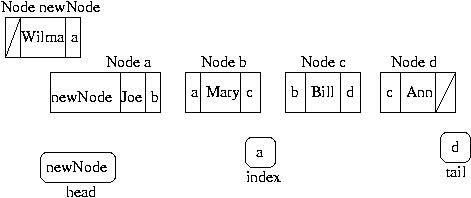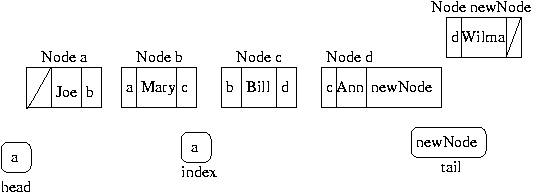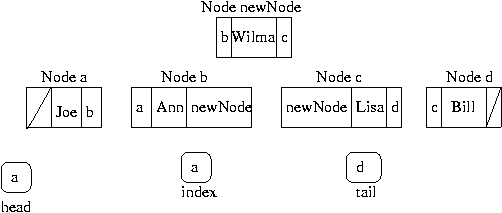As compared with Vectors, linked lists have some really nice properties
-- and some big limitations. Perhaps the most important properties of
the linked list is that it can grow and shrink smoothly, while providing
fast sequential access.
Vectors, by contrast, provide not only fast sequently access -- but also
fast indexed access. The cost comes in two parts. The first is that
growing a vector results in a large, probably unexpected penalty, as the
internal array is reallocated and copied. The second is that insertion or
removal in the middle of the list, unlike the linked list, requires
the movement of each and every subsequent node in the lists. This is also
a painful penalty.
But, looking back to linked lists for a moment, we had another penalty --
the deletion of a node from a known position, or insert the node before
the known position resulted in a partial traversal of the list -- it
was necessary to find the predecessor of the know position and there was
no direct way to move backward. This was a costly operation.
Today, we are discussing doubly linked lists (yes, they will be on the test
:-). These lists eliminate this penalty, by providing direct access to
each node's predecessor -- but, again, at a cost: an additional reference
in each node.
Doubly linked lists will have the familiar "next" and "data" references,
as well as a new reference "prev". Prev works, basically, symetrically
to "next". It does, of course, as you might imagine, add some special
cases, especially at the beginning of the list, as well.
Below is one of my favorite white lies. Intro instructors all across
the world tell this one to their students -- don't believe them!
Vectors waste more space than linked lists, because they double
in size when they grow, so they can be half-full. So, linked lists
are more space efficient.
This isn't true. Think about it this way. A vector takes one reference
per object, to keep the object in the container. Basically, it is an
array of object references, with one reference per object. So, if
it is half full, we double this cost to two references per object.
A singly linked list, by contrast, maintains the same two references
per object -- "data" and "next". So, the best and worst cases for
linked lists are the same as the worst case for a Vector. The best
case for the Vector wins by 2:1!
And, if we consider a doubly linked list, with 3 references per object,
the cost is even higher -- 50% higher than a singly linked list and 200%
higher than for a Vector.
Of course, this can change a little bit if removals are thrown into the
mix, because linked lists will shrink on removal, but Vectors will not
(even though they grow on inserts).
I guess I should also point out that you can change the growth
policy on a Vector from 2:1, to your choice of linear metrics -- but
then you risk copying the same data many times.
Doubly-Linked lists are lists which contain slightly different nodes than the ones found in
singly-linked lists. Each node references its predecessor as well as its
successor. This allows us to
look and move both forward and backward in the list.Here's a doubly-linked list. Each node has an extra reference, which we
will call prev, to the node that comes before it in the linked list (its predecessor).
Take a look at Node b. It's prev reference refers to Node a, and its
next reference refers to Node c.
Look at Node a. The dashed line in Node a's prev signifies the fact
that, because Node a is the first node in the list, its prev is null.
Look at Node d. The dashed line in Node d's next signifies the fact that,
since Node d is at the end of the list, its next is null.

null is exactly what it sounds like - nothing. This means that
you cannot refer to null.getNext() or null.getPrev()!!!
The great thing about doubly-linked lists is that, if you'd like to, say,
remove the node in the above list containing "Mary", you can set index to refer
directly to node b and delete it. How do you do this?

The thing to notice here is that there is no longer a reference to Node b,
because Nodes a and c have been reset to reference each other. Index has been
reset to refer to the first node in the list.
Let's look at the doubly-linked list class. It's much like the singly-linked
list class. The nodes have an extra reference, a reference to their predecessors
in the list. And the methods are different because we now have one more
reference to worry about.
The Node Class
Instance Variables
private class Node
{
private Object data;
private Node next;
private Node prev;
//constructors and methods
}
prev is just like next, except that prev
refers to the node's predecessor.
Constructors
public Node()
{
data = null
next = null;
prev = null;
}
public Node (Object data)
{
this.data = data;
next = prev = null;
}
public Node (Object data, Node prev, Node next)
{
this.data = data;
this.next = next;
this.prev = prev;
}
Take a another look at the second two constructors.
What's the scope of data? What's the scope of this.data?
Remember that this refers to the object you've just
made with the new operator. We want to have meaningful variable names, so
these variables have the same name. Just keep the distinction between the
data being passed into the method and the instance variable of the object.
Accessors
public Object getData ()
{
return data;
}
public Node getPrev()
{
return prev;
}
public Node getNext()
{
return next;
}
Mutators
public void setData (Object data)
{
this.data = data;
}
We could leave setData() out of the class definition, because we can always
just create a new node
every time we want to change something. But that would be more work. When we make a new node,
we'll want to set its next and prev references.
public void setPrev (Node prev)
{
this.prev = prev;
}
public void setNext (Node next)
{
this.next = next;
}
As with singly-linked lists, the Node class is a private subclass of the doubly-linked
list class. Here's the rest of the doubly-linked list class.
The doubly-linked list class is like the singly-linked list class - except that there's one more
reference to worry about.
Instance Variables
private Node head;
private Node tail;
private Node index;
Constructor
public DoublyLinkedList()
{
head = tail = index = null;
}
Adding a Node to the Beginning of the List
public void addHead(Object data)
{
// Create new node
Node newNode = new Node (data, null, head);
// Special case: Empty List
if (null == head)
{
head = tail = index = newNode;
return;
}
// Common case
head.setPrev(newNode);
head = newNode;
}
Here, newNode has been added to the front of the list.

Adding a Node to the End of the List
public void addTail (Object data)
{
// Create new node
Node newNode = new Node (data, tail, null);
// Special case: Empty list
if (tail == null)
{
tail = head = index = newNode;
return;
}
// Common case
tail.setNext (newNode);
tail = newNode;
}
Here, newNode has been added to the end of the list.
DoubleLinkedListNode Implementation
public class DLinkedListNode
{
private Comparable data;
private DLinkedListNode next;
private DLinkedListNode prev;
public DLinkedListNode()
{
data = null;
next = null;
prev = null;
}
public DLinkedListNode (Comparable data, DLinkedListNode prev,
DLinkedListNode next)
{
this.data = data;
this.next = next;
this.prev = prev;
}
public DLinkedListNode (Comparable data)
{
this.data = data;
this.next = null;
this.prev = null;
}
public void setNext (DLinkedListNode next)
{
this.next = next;
}
public void setPrev (DLinkedListNode prev)
{
this.prev = prev;
}
public Comparable getData()
{
return data;
}
public DLinkedListNode getNext()
{
return next;
}
public DLinkedListNode getPrev()
{
return prev;
}
}
DoublyLinkedList Implementation
public class DLinkedList
{
private DLinkedListNode head;
private DLinkedListNode tail;
private DLinkedListNode index;
public class DLinkedListException extends Exception
{
public DLinkedListException (String msg)
{
super(msg);
}
}
public DLinkedList()
{
head = tail = index = null;
}
public void prepend (Comparable data)
{
head = new DLinkedListNode (data, null, head);
if (head.getNext() != null)
head.getNext().setPrev(head);
if (null == tail)
tail = head;
if (null == index)
index = head;
}
public void append (Comparable data)
{
if (null == tail)
head = index = tail = new DLinkedListNode(data);
else
{
tail.setNext (new DLinkedListNode (data,tail,null));
tail = tail.getNext();
}
}
public void resetIndex()
{
index = head;
}
public Comparable getIndex() throws DLinkedListException
{
if (null == index)
throw new DLinkedListException ("Null index in getIndex()");
return index.getData();
}
public void advanceIndex() throws DLinkedListException
{
if ((index == null) || (null == index.getNext()))
throw new DLinkedListException ("Null index in advanceIndex()");
index = index.getNext();
}
public void reverseIndex() throws DLinkedListException
{
if ( (null == index) || (index == head) )
throw new DLinkedListException ("Index is null or has no predecessor");
index = index.getPrev();
}
public Comparable deleteAtIndex() throws DLinkedListException
{
Comparable data;
try
{
data = index.getData();
reverseIndex();
// data = index.getNext().getData(); // Ugly, but avoids NPE
index.setNext(index.getNext().getNext());
index.getNext().setPrev(index);
}
catch (NullPointerException npe)
{
throw new DLinkedListException ("index is null; can't delete");
}
catch (DLinkedListException lle)
{
// No predecessor; first node in list
head = index.getNext();
if (head != null)
head.setPrev(null);
}
// Index was the tail
if (index.getNext() == null)
{
tail = index;
}
// Move index to the one after the one we're deleting
index = index.getNext();
return data;
}
public Comparable removeNth (int n) // beginning with 0th
throws DLinkedListException
{
DLinkedListNode index; // Don't destroy user's index
int count;
if (null == head)
throw new DLinkedListException ("Can't delete from empty list");
if (n == 0)
{
if (tail == head)
tail = null;
if (index == head)
index = null;
head = head.getNext();
if (head != null)
head.setPrev (null);
}
else
{
try
{
for (index=head, count=0; count <= n; count++, index=index.getNext())
;
}
catch (NullPointerException npe)
{
throw new DLinkedListException ("Less than n nodes on removeNth");
}
if (index == tail)
throw new DLinkedListException ("Less than n nodes on removeNth");
if (this.index == index)
this.index = null;
if (tail == index)
tail = index.getPrev(); // same as tail=tail.getPrev()
index.getPrev().setNext(index.getNext());
if (tail != index)
index.getNext().setPrev(index.getPrev());
}
}
} /* DLinkedList */




